Related Research Articles
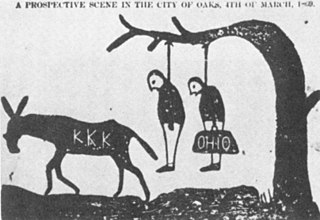
In United States history, the pejorative scalawag referred to white Southerners who supported Reconstruction policies and efforts after the conclusion of the American Civil War.

In the American Civil War (1861–65), the border states or the Border South were four, later five, slave states in the Upper South that primarily supported the Union. They were Delaware, Maryland, Kentucky, and Missouri, and after 1863, the new state of West Virginia. To their north they bordered free states of the Union, and all but Delaware bordered slave states of the Confederacy to their south.
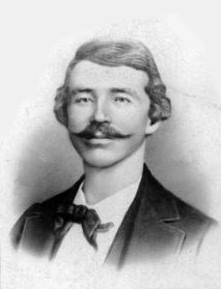
William Clarke Quantrill was a Confederate guerrilla leader during the American Civil War.
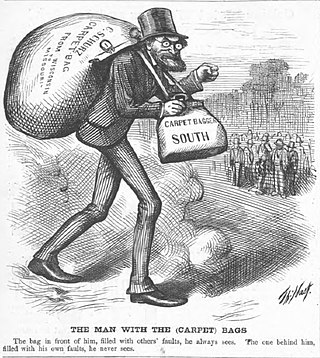
In the history of the United States, carpetbagger is a largely historical pejorative used by Southerners to describe allegedly opportunistic or disruptive Northerners who came to the Southern states after the American Civil War, and were perceived to be exploiting the local populace for their own financial, political, and/or social gain. The term broadly included both individuals who sought to promote Republican politics, and individuals who saw business and political opportunities because of the chaotic state of the local economies following the war. In practice, the term carpetbagger often was applied to any Northerners who were present in the South during the Reconstruction Era (1865–1877). The word is closely associated with scalawag, a similarly pejorative word used to describe native white Southerners who supported the Republican Party-led Reconstruction.
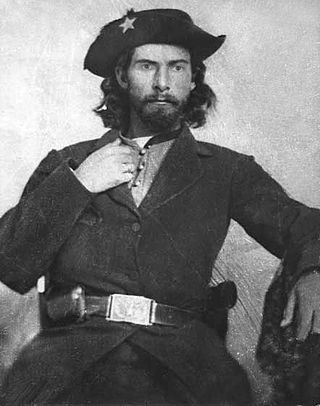
William T. Anderson, known by the nickname "Bloody Bill" Anderson, was a soldier who was one of the deadliest and most notorious Confederate guerrilla leaders in the American Civil War. Anderson led a band of volunteer partisan raiders who targeted Union loyalists and federal soldiers in the states of Missouri and Kansas.
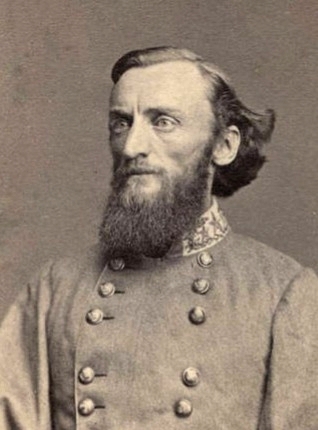
John Sappington Marmaduke was an American politician and soldier. He was the 25th governor of Missouri from 1885 until his death in 1887. During the American Civil War, he was a senior officer of the Confederate States Army who commanded cavalry in the Trans-Mississippi Theater.

The Gentle Art of Making Enemies is a book by the painter James McNeill Whistler, published in London in 1890 by William Heinemann, who also published a second, enlarged edition in 1892. The book was in part a response to, in part a transcript of, Whistler's famous libel suit against critic John Ruskin. Ruskin, in a review of the inaugural showing at the Grosvenor Gallery, had referred to Whistler's painting Nocturne in Black and Gold – The Falling Rocket as "flinging a pot of paint in the public's face". The book contains Whistler's letters to newspapers chronicling his many petty grievances against various acquaintances and friends, and it contains his famous 1885 lecture, "Ten O'Clock", explaining "the meaning and purpose of art".

The U.S. state of West Virginia was formed out of western Virginia and added to the Union as a direct result of the American Civil War, in which it became the only modern state to have declared its independence from the Confederacy. In the summer of 1861, Union troops, which included a number of newly formed Western Virginia regiments, under General George McClellan drove off Confederate troops under General Robert E. Lee at the Battle of Philippi in Barbour County. This essentially freed Unionists in the northwestern counties of Virginia to form a functioning government of their own as a result of the Wheeling Convention. Before the admission of West Virginia as a state, the government in Wheeling formally claimed jurisdiction over all of Virginia, although from its creation it was firmly committed to the formation of a separate state.

Bushwhacking was a form of guerrilla warfare common during the American Revolutionary War, War of 1812, American Civil War and other conflicts in which there were large areas of contested land and few governmental resources to control these tracts. This was particularly prevalent in rural areas during the Civil War where there were sharp divisions between those favoring the Union and Confederacy in the conflict. The perpetrators of the attacks were called bushwhackers. The term "bushwhacking" is still in use today to describe ambushes done with the aim of attrition.
The trans-Mississippi theater of the American Civil War was the scene of the major military operations west of the Mississippi River. The area is often thought of as excluding the states and territories bordering the Pacific Ocean, which formed the Pacific coast theater of the American Civil War (1861–1865).
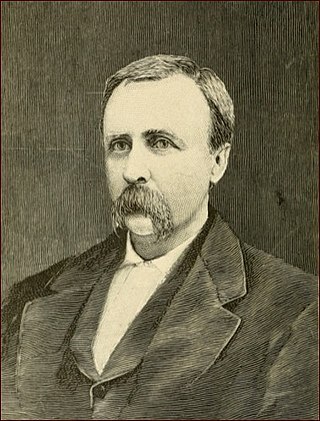
Major John Newman Edwards was famed General Joseph O. Shelby's adjutant during the American Civil War, an author, and a pro-Confederate journalist who founded the Kansas City Times. He is perhaps best known for contributing to the folk hero status of outlaw Jesse James.
Popular opposition to the American Civil War, which lasted from 1861 to 1865, was widespread. Although there had been many attempts at compromise prior to the outbreak of war, there were those who felt it could still be ended peacefully or did not believe it should have occurred in the first place. Opposition took the form of both those in the North who believed the South had the right to be independent and those in the South who wanted neither war nor a Union advance into the newly declared Confederate States of America.

During the American Civil War, Missouri was a hotly contested border state populated by both Union and Confederate sympathizers. It sent armies, generals, and supplies to both sides, maintained dual governments, and endured a bloody neighbor-against-neighbor intrastate war within the larger national war.

At the outbreak of the American Civil War in April 1861, Kansas was the newest U.S. state, admitted just months earlier in January. The state had formally rejected slavery by popular vote and vowed to fight on the side of the Union, though ideological divisions with neighboring Missouri, a slave state, had led to violent conflict in previous years and persisted for the duration of the war.
The bibliography of the American Civil War comprises books that deal in large part with the American Civil War. There are over 60,000 books on the war, with more appearing each month. Authors James Lincoln Collier and Christopher Collier stated in 2012, "No event in American history has been so thoroughly studied, not merely by historians, but by tens of thousands of other Americans who have made the war their hobby. Perhaps a hundred thousand books have been published about the Civil War."
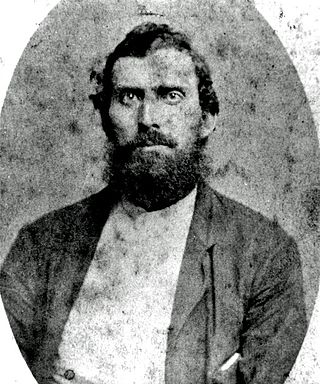
In the United States, Southern Unionists were white Southerners living in the Confederate States of America opposed to secession. Many fought for the Union during the Civil War. These people are also referred to as Southern Loyalists, Union Loyalists, or Lincoln's Loyalists. Pro-Confederates in the South derided them as "Tories". During Reconstruction, these terms were replaced by "scalawag", which covered all Southern whites who supported the Republican Party.

Guerrilla warfare was waged during the American Civil War (1861–1865) by both sides of the conflict, but most notoriously by the Confederacy. It gathered in intensity as the war dragged.

The 1st Battalion Arkansas Volunteer Infantry (1862) was an infantry battalion that served in the Union Army during the American Civil War. Although Arkansas joined the Confederate States of America in 1861, not all of its citizens supported secession.
In general the bibliography of the American Civil War comprises over 60,000 books on the war, with more appearing each month. There is no complete bibliography to the war; the largest guide to books is over 40 years old and lists over 6,000 titles selected by leading scholars. The largest guides to the historiography annotates over a thousand titles.
Mary Jane Green was a Confederate spy and bushwhacker.
References
- ↑ "Nonfiction Book Review: The Confederate Carpetbaggers by Daniel E. Sutherland". www.publishersweekly.com. January 1, 1988.
- ↑ Sutherland, Daniel E. (1997-11-02). "Southern Fortitude". The New York Times. ISSN 0362-4331 . Retrieved 2024-05-02.
- ↑ "Daniel E. Sutherland | C-SPAN.org". www.c-span.org. Retrieved 2024-05-02.
- ↑ Sutherland, Daniel E. (January 1, 1999). Guerrillas, Unionists, and Violence on the Confederate Home Front. University of Arkansas Press. ISBN 9781557285508 – via Google Books.
- ↑ "Book Review: Guerrillas, Unionists, and Violence on the Confederate Home Front (edited by Daniel E. Sutherland): CWT". HistoryNet. August 12, 2001.
- ↑ Dotson, Rand (2001). "Guerrillas, Unionists, and Violence on the Confederate Home Front". The Virginia Magazine of History and Biography. 109 (2): 230–231. ProQuest 195919235.
- ↑ Reidy, Joseph P. (1990). "The Confederate Carpetbaggers (review)". Civil War History. 36 (1): 83–85. doi:10.1353/cwh.1990.0024. S2CID 144970517. Project MUSE 420548.
- ↑ Sutherland, Daniel E. (June 1, 1988). The Confederate Carpetbaggers. LSU Press. ISBN 9780807114704 – via Google Books.
- ↑ Neely, Jeremy (2009). "A Savage Conflict: the Decisive Role of Guerrillas in the American Civil War". Civil War Book Review. 11 (4).